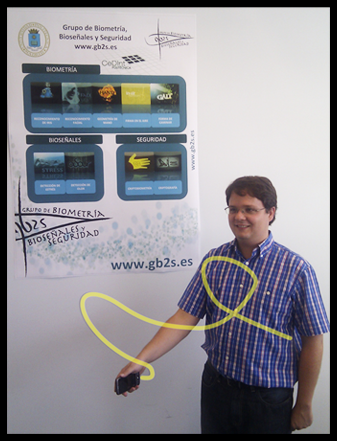In-air signature, a new biometric technique for authentication in mobile phones
A new system has been developed whic verifies ID of the mobile phone users through the use of an in-air signature. Biosignals and Security (GB2S) and the Research Centre for Smart Buildings and Energy Efficiency (CeDInt) of the UPM are the co-creators of this system.
This new biometric technique for authentication provides greater security than the PIN code. The PIN code can be guessed, lost, copied or stolen when performing sensitive operations such as email, on-line banking or on-line shopping which require the verification of identity through the PIN.
The proliferation of 3rd generation mobile telecommunications and falling broadband prices offer the possibility of accessing a variety of services anywhere. Nowadays, several leading companies are pioneering the use of mobile phone as a means of payment (“Google Wallet”).
GB2S are concerned with security of these services and operations by using biometric and cryptographic techniques. They propose using an innovative biometric technique based on the performance of an identifying gesture, done whilst holding a mobile phone embedded with an accelerometer in his/her hand. From this sensor, the biometric system is able to extract the relative information of the accelerations in each axis of the signature, which will be used to verify the identification of the mobile phone user and will allow them to carry out the operations safely
 The GB2S carried out various experiments to assess the accuracy of the in-air signature technique on mobiles devices. To do this, they collected a sampling of in-air signatures from different locations within the Universidad Politécnica de Madrid. The 100 participants in the creation of the database performed his signature in the air whilst holding a mobile and being recorded by a camcorder. Later, other users tried to forge signatures from the study of these films (6 forgers per signature).
The GB2S carried out various experiments to assess the accuracy of the in-air signature technique on mobiles devices. To do this, they collected a sampling of in-air signatures from different locations within the Universidad Politécnica de Madrid. The 100 participants in the creation of the database performed his signature in the air whilst holding a mobile and being recorded by a camcorder. Later, other users tried to forge signatures from the study of these films (6 forgers per signature).
From this database, they developed and evaluated various algorithms to analyse the in-air signature. They minimized the system error until it achieved a rate of forgery close to 3%. Later, other users tried to forge signatures from the study of these films (6 forges per signature). Despite forgers having a recording of the original signature, it could not be reproduced, thus proving the authencity of the technique.
The Group consider the means of increasing security of people fundamental. For that reason, they also study other biometric techniques such as recognition by hand geometry, iris, fingerprint, face, ways of walk and smell. The joining of these techniques with cryptography has resulted in the Crypto-Biometric lines to generate cryptographic keys from biometric features. GB2S is also envolved in projects related to biosignals to detect stress or diseases such as cancer through body odor or the breath.
Source: UPM
G. Bailador del Pozo, C. Sánchez Ávila, J. Guerra Casanova & A. de Santos Sierra, “Analysis of pattern recognition techniques for in-air signature biometrics”, Pattern Recognition, 44 (10-11), pp.: 2468-2478, 2011.
J. Guerra Casanova, C. Sánchez Ávila, A. de Santos Sierra & G. Bailador del Pozo, “Score optimization and template updating in a biometric technique for authentication in mobiles based on gestures”, Journal of Systems and Software, 84 (11), pp.: 2013-2021, 2011.

